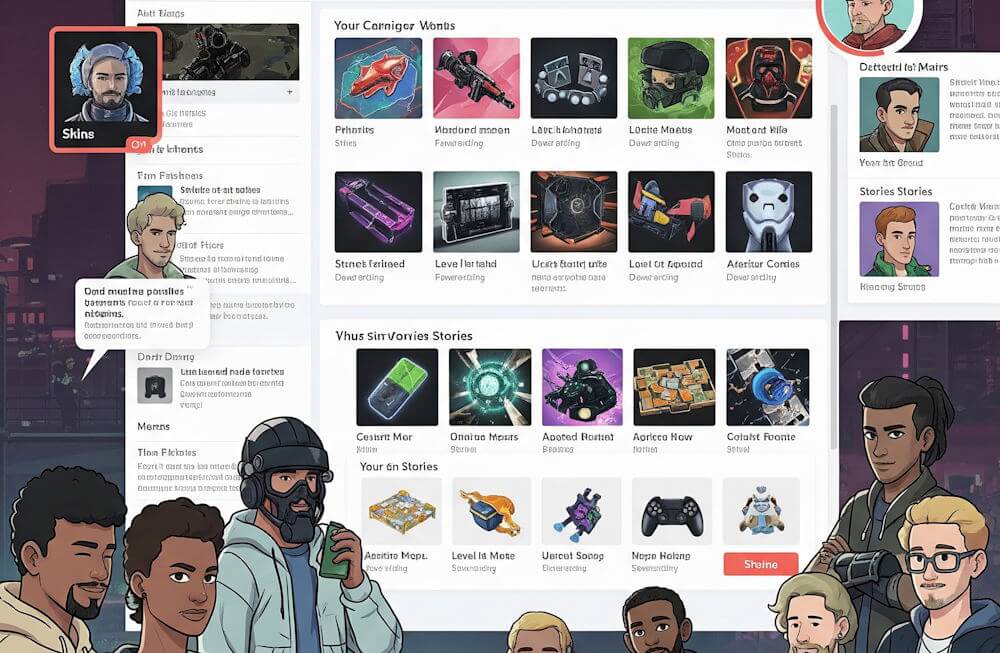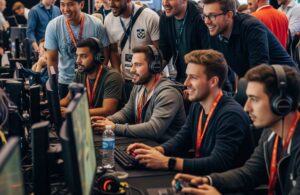Introduction to User-Generated Content in Gaming
User-generated content (UGC) in the gaming industry refers to creations made by players that contribute to and enhance the gaming ecosystem. This content can take numerous forms, including modifications (mods), fan art, gameplay videos, tutorials, and community blogs. As players engage with games, their creativity often manifests in ways that not only showcase their passion but also significantly enrich the overall gaming experience for themselves and others within the community.
The rise of user-generated content has become increasingly relevant in today’s gaming landscape. As gaming technology evolves, developers have encouraged players to share their creations, fostering a collaborative and vibrant community. UGC provides a platform for players to express their individuality, inviting them to innovate and push the boundaries of existing game mechanics. The interconnectedness of gaming communities thrives on content created by users, allowing for unique interpretations and experiences within the same game world.
Furthermore, UGC acts as a catalyst for community engagement, as players share their work through various platforms, leading to discussions and feedback among peers. This exchange of ideas not only enhances creativity but also develops a sense of belonging among gamers. By participating in UGC, players contribute to a larger narrative within the gaming community, where their input is valued and acknowledged. The proliferation of social media and streaming platforms has amplified this phenomenon, making it easier for gamers to showcase their creations to a global audience.
In exploring the diverse forms of user-generated content and its implications, it becomes evident that UGC plays a pivotal role in shaping the gaming culture. From fostering creativity to enhancing player engagement, user-generated content is an integral component of the gaming ecosystem, ultimately transforming how gamers interact with their favorite titles and each other.
The Evolution of Gaming Fandoms
The evolution of gaming fandoms has been marked by significant milestones that have transformed them from niche groups into vibrant and diverse communities. The origins of gaming fandoms can be traced back to the early days of video gaming in the 1970s and 1980s. At that time, players often gathered in small, localized groups to discuss their favorite games and share strategies. These interactions were primitive compared to today’s standards, usually taking place in-person or through printed fanzines.
As the gaming landscape expanded, so did the methods of communication among players. The advent of the internet in the 1990s ushered in a new era for gaming fandoms. Dedicated online forums and fan sites emerged, providing gamers with platforms where they could congregate and discuss game mechanics, plot theories, and character analyses. These platforms facilitated connections beyond geographical limitations, enabling players from around the world to form friendships and united interests in specific games or genres.
The rapid growth of these online communities laid the groundwork for the rise of social media in the mid-2000s. Platforms such as Facebook, Twitter, and later platforms like Reddit and Discord revolutionized how gamers interacted. Gamers could now share content more easily, such as gameplay videos, fan art, and mods, thereby enriching the gaming experience through collective creativity. This democratization of content sharing not only strengthened existing fandoms but also led to the emergence of diverse sub-communities based on specific games or gaming philosophies.
In addition, as mobile and indie games surged in popularity, new fandoms formed around these titles, showcasing the expansive nature of gaming culture. Today, gaming fandoms continue to thrive, driven by user-generated content (UGC) that enhances player engagement and fosters a sense of belonging among gamers. The extensive evolution of gaming fandoms highlights how technological advancements have paved the way for increased collaboration and creativity, significantly contributing to the gaming culture we know today.
How User-Generated Content Strengthens Community Bonds
User-generated content (UGC) has emerged as a pivotal element in the realm of gaming fandoms, acting as a catalyst for community building and engagement. Through the sharing of personal creations, such as mods, fan art, or gameplay videos, players can express their unique perspectives on a shared passion. This collective involvement fosters a sense of belonging, encouraging interaction and collaboration within the gaming community. When individuals contribute their creativity, they transcend the role of passive consumers, becoming active participants in a larger narrative.
User-generated content serves not only as a means of self-expression but also as a powerful tool for enhancing the bonds among community members. When gamers showcase their modifications to popular titles or share original artwork inspired by their favorite games, they invite discussions and prompt feedback. This exchange of ideas and emotions cultivates an environment where members of the fandom feel valued and connected to one another. As such, UGC engenders deeper relationships, as fans can relate not just to the games themselves, but also to the creators behind the content.
In summary, user-generated content enriches the gaming experience by strengthening community bonds. It transforms fandoms from mere groups of players into interconnected networks of creators and collaborators, ultimately fostering a vibrant gaming culture that thrives on shared passion and creativity.
Enhancing Gameplay and Player Experience Through UGC
User-generated content (UGC) has become an integral component of the modern gaming landscape, significantly enhancing gameplay and player experience. As gaming communities flourish, the creative contributions of players have introduced a plethora of modifications (mods) that transform games in unprecedented ways. These user-generated modifications can add entirely new dimensions to gameplay, introducing fresh mechanics, reimagined graphics, and additional storylines that enrich the player’s journey within the virtual worlds they inhabit.
The capability for players to create and share content has effectively extended the life of existing titles. When a game’s official content starts to dwindle, dedicated enthusiasts often step in to fill the void. These players develop mods that can rejuvenate interest in the game, introducing new features or altering gameplay to keep it engaging. For instance, some mods may introduce enhanced difficulty settings, while others can unlock previously unavailable story arcs or characters. Consequently, UGC ensures that even years after a game’s release, players still find value and excitement, prolonging the title’s relevancy in an ever-evolving market.
Additionally, the influence of fan-made content is evident in how it shapes game updates and developer decisions. Game developers often monitor player feedback and are increasingly aware of trends within the community. Countless instances highlight where constructive feedback derived from UGC has led to significant changes in games. Developers might incorporate popular mods into official updates, adapting their vision to align with player preferences. This collaborative relationship fosters a dynamic environment where community-driven innovation can coalesce with official game design, ultimately leading to more refined gaming experiences and heightened player satisfaction.
The Creative Power of Fan Art and Storytelling
Fan art and storytelling represent a vital element of the gaming community, allowing players to engage with their favorite titles on a profound level. Through various forms of artistic expression, including illustrations, written narratives, and multimedia projects, fans breathe new life into the universes they cherish. This iteration of the original game content not only showcases their enthusiasm but also stimulates creativity and a sense of belonging among followers of different franchises.
One of the most common ways players express their devotion is through fan art. These visual representations can take various forms, from traditional drawings and paintings to digital illustrations, each capturing the essence of beloved characters and iconic scenes. Such artworks often clarify and expand upon existing narratives, offering interpretations that resonate with fellow fans. As a result, they foster a collaborative environment where players can share, critique, and inspire one another, thereby strengthening their collective identity within the gaming fandom.
In addition to visual art, fan fiction plays an essential role in enhancing gaming narratives. By crafting unique stories, players explore alternative plotlines, character developments, or even entirely new adventures set within familiar worlds. This literary creativity not only enriches the overall lore but also serves as an emotional outlet for players. As they delve deeper into character backgrounds or fictional scenarios, they form more meaningful connections to the source material and fellow fans. Engaging in these collaborative storytelling efforts encourages dialogue and bonding, ultimately reinforcing the community dynamic.
Additionally, videos and multimedia creations, such as animations and gameplay montages, contribute significantly to the gaming landscape. These artistic endeavors serve as platforms for fans to showcase their skills while celebrating the games they love. In essence, fan art and storytelling emerge as powerful tools of expression that foster creativity and deepen connections, enriching the gaming experience for all involved.
Navigating the Challenges of User-Generated Content
User-generated content (UGC) has emerged as a significant aspect of the gaming industry, providing players an avenue for creativity and a deeper connection to their favorite games. However, this phenomenon also brings forth a range of challenges, which must be addressed to cultivate a healthy gaming ecosystem. One of the primary concerns revolves around copyright issues. Many creators navigate a delicate landscape where they must ensure their content does not infringe upon the intellectual property rights of game developers. Disputes over ownership can lead to legal ramifications, affecting both creators and the platforms that host such content.
Moreover, community conflicts can arise when UGC sparks debates about the direction of a game or its core elements. For instance, modifications or fan-created content may present alternate narratives or gameplay mechanisms that contrast with a developer’s vision. While these contributions are often well-intentioned, they can polarize communities, resulting in rifts among players who favor traditional content versus those who embrace innovation. This underscores the necessity for open dialogue between developers and fans to promote understanding and collaboration rather than conflict.
Finding a balance between developer control and user creativity is critical in mitigating these challenges. Developers must create frameworks that allow for expression while establishing clear guidelines that protect their intellectual property. Ethical considerations play a pivotal role in this process. Communities should actively foster an environment that encourages original expression while respecting the boundaries set by game developers. By promoting ethical UGC practices, players can engage in creative endeavors that enhance the gaming experience without infringing on the rights and intentions of the original creators. Ultimately, fostering collaboration can lead to more enriching and diverse gaming ecosystems.
The Role of Developers in Supporting UGC
The involvement of game developers in supporting user-generated content (UGC) has become increasingly important in the contemporary gaming landscape. By facilitating platforms and tools that enable gamers to create, share, and enjoy custom content, developers are not merely producers; they evolve into active participants in the gaming community. This symbiotic relationship between developers and fans fosters a culture of collaboration, innovation, and engagement within gaming environments.
One effective approach that some developers have adopted is the provision of dedicated toolkits for content creation. For instance, popular titles like “Minecraft” and “Roblox” have integrated comprehensive creation tools that allow players to build their unique gaming experiences. These platforms empower fans to showcase their creativity, leading to a rich diversity of gameplay options and enhancing the overall player experience. Additionally, developers may also encourage community input during the game development process, inviting feedback and suggestions that can shape future updates or expansions. Such practices not only validate fan contributions but also cultivate a sense of ownership among players.
Furthermore, hosting contests is another strategy employed by developers to bolster UGC. Events like modding competitions allow players to demonstrate their skills, often resulting in exceptional content that can be integrated into the broader game. For instance, games like “The Elder Scrolls V: Skyrim” have seen a flourishing modding community where developers have actively featured user creations, shining a spotlight on these efforts and inspiring other gamers to participate. This recognition fosters a vibrant community spirit and deepens players’ emotional investment in the game.
In summary, the role of developers in supporting user-generated content is pivotal. By providing resources, recognizing fan contributions, and fostering community engagement, developers not only enhance the gaming experience but also ensure the longevity and relevance of their franchises within the dynamic gaming landscape.
Case Studies of Successful Fan-Driven Content in Gaming
User-generated content (UGC) has dramatically transformed the gaming landscape, fostering creativity and engagement within communities. One prominent example is the modding of “The Elder Scrolls V: Skyrim.” Since its release in 2011, Skyrim has seen an expansive array of mods created by fans. Notable mods such as “SkyUI,” which enhances the user interface, and “Enderal,” a total conversion mod that features a new world, story, and characters, demonstrate how UGC can elevate gameplay experiences. These modifications not only enrich the original game but also showcase the talent and dedication of the fandom, ultimately extending Skyrim’s lifecycle and solidifying its status in gaming culture.
Another exemplary case is the explosion of fan art surrounding the game “Undertale.” This indie title gained immense popularity not only for its engaging gameplay and narrative but also for the vibrant community that arose around it. Artists from all over the world produced fan art that captured the game’s unique characters and emotional depth. The community’s engagement through art, in turn, generated a significant social media presence, further propagating the game’s popularity. By sharing their works, fans helped foster a welcoming environment that encouraged others to engage with Undertale, amplifying the game’s success and cementing its place within gaming history.
Furthermore, the popular game “Team Fortress 2” provides a clear illustration of how UGC can contribute to a game’s success. Through the Steam Workshop, players have created countless cosmetic items, maps, and game modes. One standout example is the “Mann vs. Machine” cooperative game mode, which was initially a fan submission. Upon its integration into the official game, it revitalized player interest and expanded the game’s horizon beyond traditional competitive play. Such contributions reinforce the bond between the developers and the gaming community, highlighting the potential impact of fan-driven content on not only gameplay but also on the larger gaming ecosystem.
Future Trends: The Next Chapter for UGC and Gaming Fandoms
The landscape of user-generated content (UGC) within gaming fandoms is poised for significant transformation, primarily driven by technological advancements. Virtual reality (VR) and augmented reality (AR) are emerging as critical influencers, offering immersive experiences that deepen engagement within gaming communities. With VR, creators can develop lifelike, interactive environments that invite players to not just observe but actively participate in the content creation process. This shift is likely to cultivate stronger connections among users, as they collaborate and innovate in these shared spaces.
In addition to VR and AR, artificial intelligence (AI) is increasingly at the forefront of content generation. AI tools can empower creators by streamlining the design process and suggesting modifications to enhance gameplay or visual aesthetics. With AI-generated content, gaming developers and fans alike may find new pathways for creativity, as the technology facilitates rapid prototyping and experimentation. This could lead to an explosion of diverse content, influenced by a wide spectrum of game genres and player preferences.
The rise of new platforms and tools specifically tailored for UGC also holds significant implications for community engagement. Platforms that enable seamless sharing of player-generated content will not only provide venues for creativity but also foster a sense of belonging among gamers. It is anticipated that niche communities will emerge, driven by shared interests and innovative content, which could further influence the dynamics of gaming fandoms.
As these technologies evolve, the relationship between gamers and their content is expected to deepen, leading to more collaborative and dynamic interactions. This evolving landscape presents exciting possibilities for gamers, suggesting that the next chapter in UGC will not just reflect fandoms but actively shape their future. By embracing these trends, gaming communities will redefine their identities and strengthen their collective narratives.



